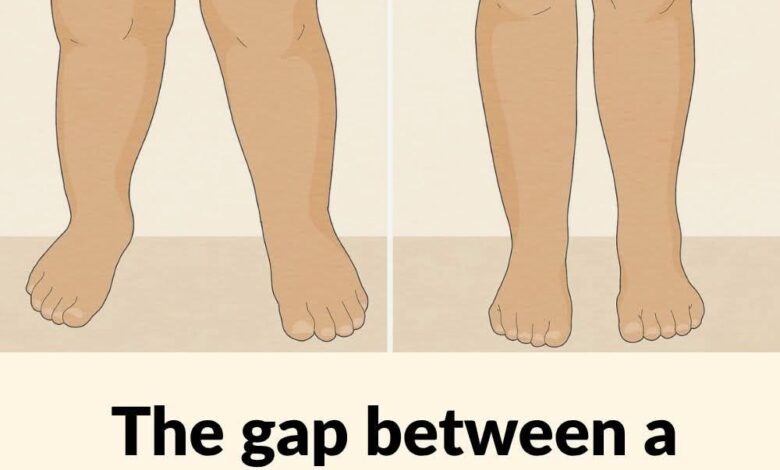Understanding Body Anatomy: The Science Behind Natural Body Variations and Health

Why Body Diversity Matters: A Medical Perspective on Natural Anatomical Differences
In today’s health and wellness landscape, understanding the science behind natural body variations has become increasingly important. Many fitness enthusiasts and health-conscious individuals seek to understand why certain anatomical features appear differently across various body types. This comprehensive guide explores the medical facts behind natural body diversity and promotes evidence-based approaches to health and fitness.
The Science of Human Anatomy: What Medical Experts Want You to Know
Understanding Natural Body Structure Variations
Despite evolving fitness trends and wellness movements, certain anatomical characteristics continue to generate interest in health and fitness communities. One such feature is the natural spacing between the upper legs when standing, which has gained attention in fitness and wellness circles.
Medical professionals emphasize that this anatomical variation is primarily determined by genetic factors rather than lifestyle choices. According to leading orthopedic specialists and anatomy experts, the appearance of leg positioning depends on several unchangeable biological factors.
The Role of Skeletal Structure in Body Shape
Healthcare professionals consistently explain that individual body shapes are largely determined by:
- Pelvic bone width and orientation
- Femur bone angle and positioning
- Natural muscle distribution patterns
- Genetic predisposition to body composition
These structural elements are established during development and remain consistent throughout life, regardless of diet modifications or exercise routines.
Medical Expert Insights on Body Diversity
What Healthcare Professionals Say
Dr. Ross Perry, a respected British medical expert, emphasizes that natural anatomical variations are simply the result of individual bone structure arrangements. These variations are not indicators of health status, fitness levels, or lifestyle choices.
Medical research consistently shows that bone structure cannot be altered through diet or exercise. Whether an individual has naturally positioned leg bones or differently angled pelvic structures, these characteristics are determined by genetics and normal anatomical development.
The Reality of Body Image in Healthcare
Healthcare providers note that even individuals with very low body fat percentages may not display certain anatomical features due to their natural bone structure. This medical reality helps explain why many people, regardless of their fitness dedication or nutritional discipline, may never achieve certain aesthetic goals.
Professional medical imaging and anatomical studies confirm that many images in media and advertising often undergo digital enhancement, creating unrealistic expectations about natural body appearances.
Mental Health and Wellness: Addressing Social Pressure
The Psychology of Body Image
Mental health professionals express growing concern about the impact of unrealistic body standards on psychological well-being. Research indicates that pursuing unattainable physical goals can lead to:
- Decreased self-confidence and self-esteem
- Unhealthy exercise behaviors and overtraining
- Restrictive eating patterns and nutritional deficiencies
- Increased anxiety and depression related to body image
These psychological impacts are particularly concerning among young adults and teenagers, who are more susceptible to social media influence and peer pressure.
The Importance of Mental Health Support
Healthcare providers emphasize that mental wellness is just as important as physical health. Understanding and accepting natural body diversity contributes to better overall mental health outcomes and improved quality of life.
Evidence-Based Approaches to Health and Fitness
Refocusing on Healthy Lifestyle Goals
Rather than pursuing specific aesthetic targets, medical professionals recommend focusing on achievable health and wellness objectives:
Cardiovascular Health:
- Regular aerobic exercise for heart health
- Maintaining healthy blood pressure and cholesterol levels
- Improving overall endurance and stamina
Strength and Mobility:
- Building functional strength for daily activities
- Maintaining bone density through resistance training
- Improving flexibility and joint mobility
Nutritional Wellness:
- Balanced nutrition for optimal energy levels
- Adequate hydration for bodily functions
- Proper nutrient intake for immune system support
The Science of Targeted Exercise
Exercise physiologists explain that while specific exercises can strengthen and tone particular muscle groups, they cannot alter fundamental bone structure or selectively reduce body fat in specific areas. The concept of “spot reduction” has been thoroughly debunked by sports science research.
Effective fitness programs focus on overall health improvements rather than attempting to change unchangeable anatomical features.
Professional Recommendations for Body Acceptance
Building a Positive Relationship with Your Body
Healthcare professionals and wellness experts recommend developing a healthy relationship with your body through:
Self-Acceptance Strategies:
- Recognizing and celebrating your body’s capabilities
- Focusing on health markers rather than appearance
- Practicing mindfulness and body gratitude
- Seeking support from qualified professionals when needed
Media Literacy:
- Understanding digital enhancement in media
- Following diverse, body-positive content creators
- Limiting exposure to unrealistic beauty standards
- Educating yourself about natural body diversity
The Bottom Line: Embracing Health Over Appearance
Medical professionals consistently emphasize that true health and wellness come from accepting and caring for your natural body type rather than trying to conform to specific aesthetic standards. Every individual’s anatomy is unique, and this diversity is a normal part of human biology.
The most important health goals are those that improve your overall well-being, energy levels, and quality of life. By focusing on evidence-based health practices and accepting your natural body structure, you can achieve genuine wellness and maintain a positive relationship with your body throughout your life.
Remember: your worth and health are not determined by specific physical characteristics, but by how well you care for your overall physical and mental well-being.